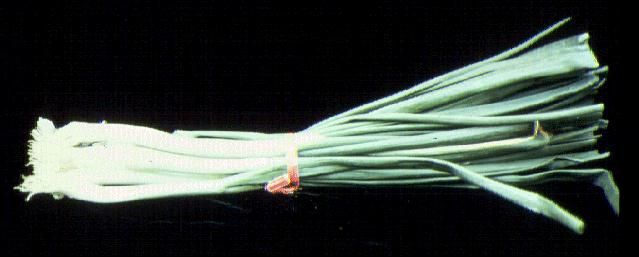Onion, Welsh—Allium fistulosum L.1
The Welsh onion is also known as spring onion, ciboule (French), zwiebel (German), negi, chibol, sybie, sybow, and stone leek. "Welsh" is a corruption of the German walsch, meaning "foreign," and has no reference to Wales. The onion originated in Siberia, and is very popular in the East where it is known as Japanese leek. A variety of this is referred to as Japanese bunching onion or nebuka. There is also a perennial Welsh onion (A. lusitanicum).

Credit: Blue Goose Inc.
Description
The leaves of Welsh onion are round, hollow, and inflated the entire length of 6 to 20 inches. The flower stalk (scape) is also hollow. The plant has only slightly enlarged bulbs, which are very long and are covered with dry membranous, onion-like scales for some distance aboveground. The color of the bulbs ranges from white to pink. The black, angular seeds are similar to common onion seeds.
Culture
Welsh onion is frost hardy but will not withstand a severe freeze. Varieties that are adapted to northern areas lose their leaves during the winter months. While the Welsh onion is not a popular Florida vegetable garden item, it appears likely that it would grow and produce well in all areas of the state.
Plant Welsh onion in the fall, winter, or spring, using seeds or divisions (transplants). Plants multiply by producing side shoots, which can be divided and reset. Set the divisions or sow the seeds in rows 1 foot apart. Space plants 6 inches apart in the row. The perennial type produces no seed, so must be propagated vegetatively.
Use
The entire plant may be pulled and eaten like a green onion as early as when 3–4 inches high, or leaf portions may be snipped off as needed for flavoring. If pulled as a green onion, 4 to 5 months are required from seeding to harvesting.


